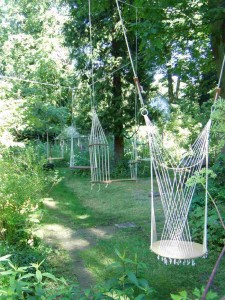Promised Eveline to be on the lookout for play stuff - moments of free-form play…
Swing – but respectably
 Found another artist using ‘play’. In 2007, the garden of museum Singer in Laren was adorned by a network of swings, an installation of artist Chiel Kuijl. The installation was meant to be used, to be played with. The swings are connected, the network they form offers a collection of (possible) movements. The swings themselves are beautifully constructed by suspending organic-formed wooden slabs in webs of rope.
Found another artist using ‘play’. In 2007, the garden of museum Singer in Laren was adorned by a network of swings, an installation of artist Chiel Kuijl. The installation was meant to be used, to be played with. The swings are connected, the network they form offers a collection of (possible) movements. The swings themselves are beautifully constructed by suspending organic-formed wooden slabs in webs of rope.
This is what Chiel Kuijl is researching: movements within organic networks, be they computer networks, economic systems, the habitue’s of a pub: he states that the network rules are always the same and represent society as a whole. The parts that make up the network consist of overlapping groups with direct and indirect links. A small movement will be propagated through the network in unexpected ways, showing the connections and effects of network parts upon one another. Any disturbance will be both propagated and absorbed within the network.
So the experience one can get from participating in this work is the experience of being part of a network. Nice!
I will quote part of the video interview he posted on his site, the part that especially caught my attention. It is in dutch, so the translation here is mine. I post it because I became interested in the hesitant way the swings are called ‘art’. I also noticed the artist de-emphasising the ‘play’ element of his work and the energetic way he rejects the idea of his swings being made ‘for children’. Carsten Holler does the same: he adds a layer of theory to his slides, calling them ‘alternative modes of transportation’ . Holler also maintains that slides can help combat stress and depression. It seems that ‘play’ has to be covered up and wrapped in a cloak of science and respectability.
Interviewer: your art, eh, your swings, are here at the museum. When people enter here, what can they see, what can they expect?
Chiel: it is very simple really. There are hanging pieces of furniture, relaxed hang-couches, somewhere between a hammock and a swing, hanging in this beautiful museum garden. One can sit on them, play with them. A number of the swings are connected into networks, so if you sit on one swing the other swing will move as well, the same as with a see-saw, you set each other in movement. You are in contact with each other while moving.
Interviewer: How much fun is it for children to visit your exposition this summer?
Chiel: It is even more fun for parents to come with their children and sit on the swings. They are explicitly not made for children, they are great for grown-ups to sit on. For me the most important issue is that they are good to sit on for me myself, to lounge on, that is my standard. That they are fun for kids to play on is really secondary.
| « Inventarisation no 08 | <-- previous post | next post --> | Keeping your question alive » |
|---|







